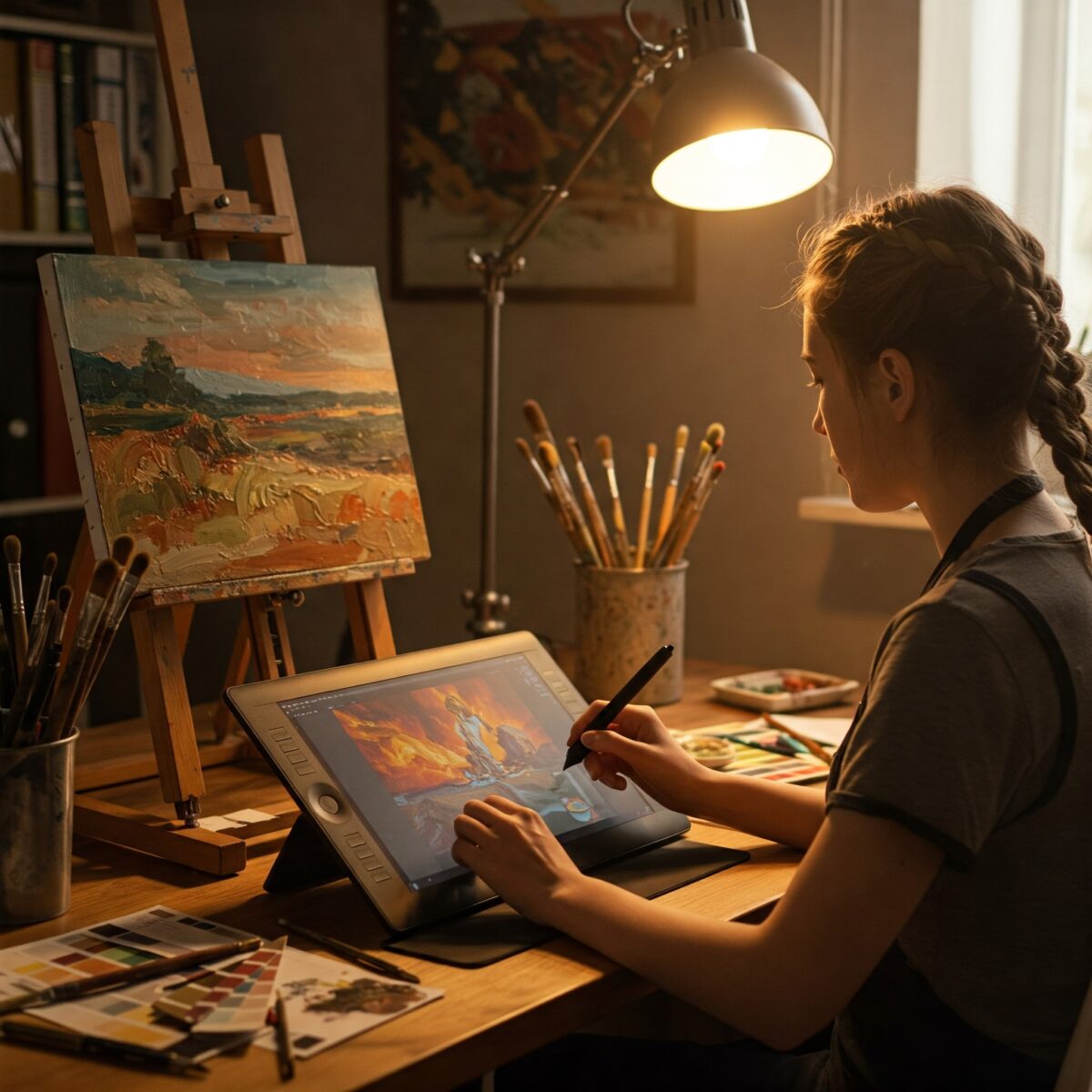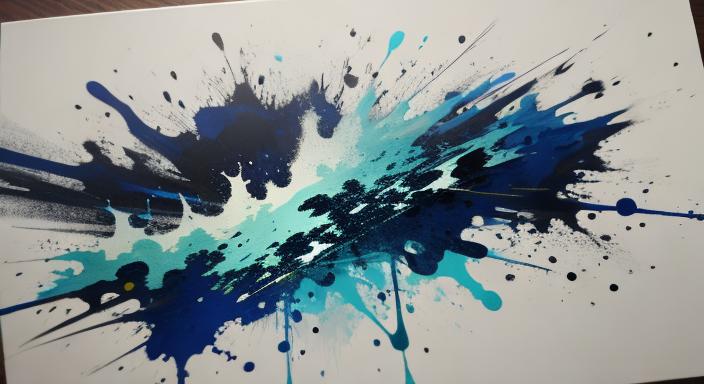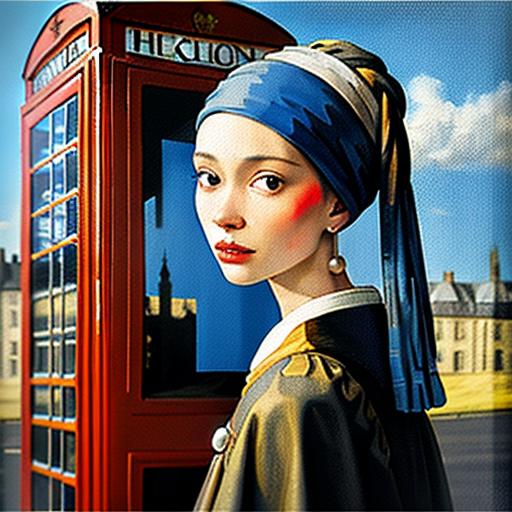Discover Art: Your Guide to Diving into CreativityIn today’s creative world, the technology influence on art has completely transformed how artists create, share, and sell their work. From the earliest cave paintings using primitive tools to today’s AI-generated masterpieces, technology has always shaped artistic expression. This relationship between art and technology isn’t new, but the digital revolution has accelerated changes at an unprecedented pace, creating exciting new possibilities while challenging traditional notions of creativity, ownership, and what we even consider “art” in the first place.
Key Points:
- Technology has influenced art throughout history, from basic tools to digital platforms
- Digital tools have democratized art creation and distribution
- AI, VR, and NFTs represent the latest frontier in art technology
- Traditional and digital techniques increasingly complement each other
- Technology raises new questions about creativity, ownership, and authenticity
The Historical Evolution of Technology Influence on Art
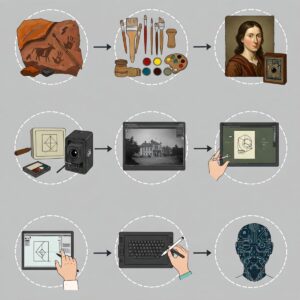
The relationship between technology and art dates back to prehistoric times. Early humans created cave paintings using charcoal, earth pigments, and primitive brushes—the cutting-edge technology of their era. As civilizations advanced, so did artistic tools and techniques.
The Renaissance brought significant technological innovations with improved pigments, canvas preparation, and the development of perspective techniques. The camera obscura, a precursor to modern photography, allowed artists like Vermeer to achieve remarkable precision in their paintings.
The Industrial Revolution introduced manufactured paints, better brushes, and eventually photography, which dramatically changed how artists approached representation. The 20th century brought even more rapid change with acrylic paints, airbrushes, and eventually, the computer.
As art educator and technology specialist Mark Rothko once noted: “Technology doesn’t replace artistic skill—it extends the artist’s capabilities and opens new avenues for expression.”
How Digital Tools Impact Traditional Painting Techniques
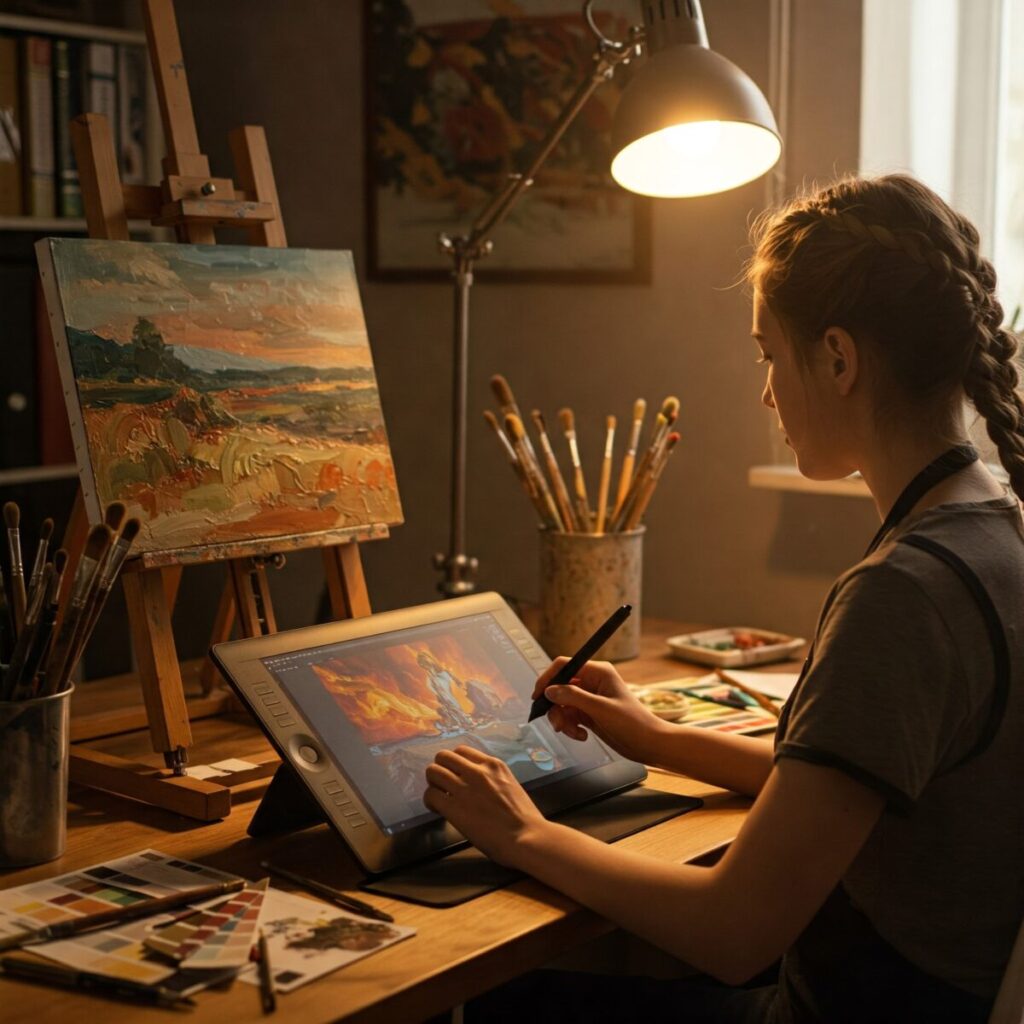
Today’s artists often blend traditional and digital approaches in their creative process. Digital tools have revolutionized how artists plan, execute, and refine their work.
Many painters now begin with digital sketches, allowing for easy experimentation with composition, color schemes, and concepts before committing to physical materials. Apps and software provide virtual studios where artists can try countless variations without wasting supplies.
Even traditional painters benefit from digital reference libraries, technique tutorials, and color theory tools. The ability to digitize traditional paintings has become essential for artists wanting to preserve their work and share it online.
There’s also a fascinating trend of making digital art look traditional, with artists applying textures and techniques that mimic physical media. This crossover shows the complementary relationship between digital and traditional approaches.
The Rise of New Art Forms Through Technology
The technology influence on art has created entirely new art forms that couldn’t exist without digital tools:
- Digital Art: Created entirely on computers using specialized software
- New Media Art: Interactive installations using technology as both medium and subject
- Generative Art: Artwork created through autonomous systems or algorithms
- Virtual Reality Art: Immersive experiences in computer-generated environments
- Augmented Reality Installations: Digital elements overlaid on physical spaces
- 3D Printed Sculptures: Physical objects created from digital designs
As technology evolves, so do these art forms. The boundaries between digital and physical art continue to blur, creating hybrid forms that challenge traditional categorizations.
“Technology is allowing artists to communicate their vision in ways previously impossible. It’s not replacing artistic skill—it’s expanding what’s possible.”
Digital artist Beeple (Mike Winkelmann)
AI Collaboration with Human Artists
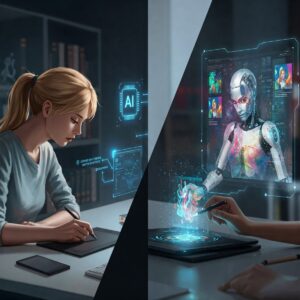
Artificial intelligence represents one of the most significant technology influences on art in recent years. AI tools like DALL-E, Midjourney, and Stable Diffusion can generate stunning images from text prompts, raising questions about creativity and authorship.
Many artists now work collaboratively with AI, using it as a tool rather than a replacement. The human artist provides the vision, refines the output, and makes critical creative decisions. This partnership creates possibilities that neither human nor machine could achieve alone.
The relationship between AI and art ethics remains complex. Questions about copyright, creative attribution, and the nature of creativity itself continue to evolve as the technology advances.
For artists interested in exploring this frontier, learning AI art prompt engineering has become an essential skill—demonstrating how technical knowledge increasingly complements traditional artistic abilities.
The Democratization of Art Creation and Distribution
Technology has dramatically lowered barriers to artistic creation and distribution:
| Traditional Art World | Technology-Enabled Art World |
|---|---|
| Formal training often required | Self-education through online resources |
| Expensive materials and studio space | Digital tools accessible on common devices |
| Gallery representation needed for visibility | Direct audience connection through social media |
| Geographic limitations for collaboration | Global creative communities online |
| Limited audience reach | Potential for worldwide audience |
| High costs for art collectors | Digital art accessible at various price points |
This democratization has allowed voices previously excluded from the art world to find audiences. Artists from diverse backgrounds can now share their perspectives globally without traditional gatekeepers.
Platforms like Instagram, TikTok, and dedicated art communities have created new pathways to artistic recognition. How TikTok is shaping contemporary painting styles shows the profound impact social media has on artistic trends and visibility.
Virtual Reality: Transforming Art Viewing and Creation
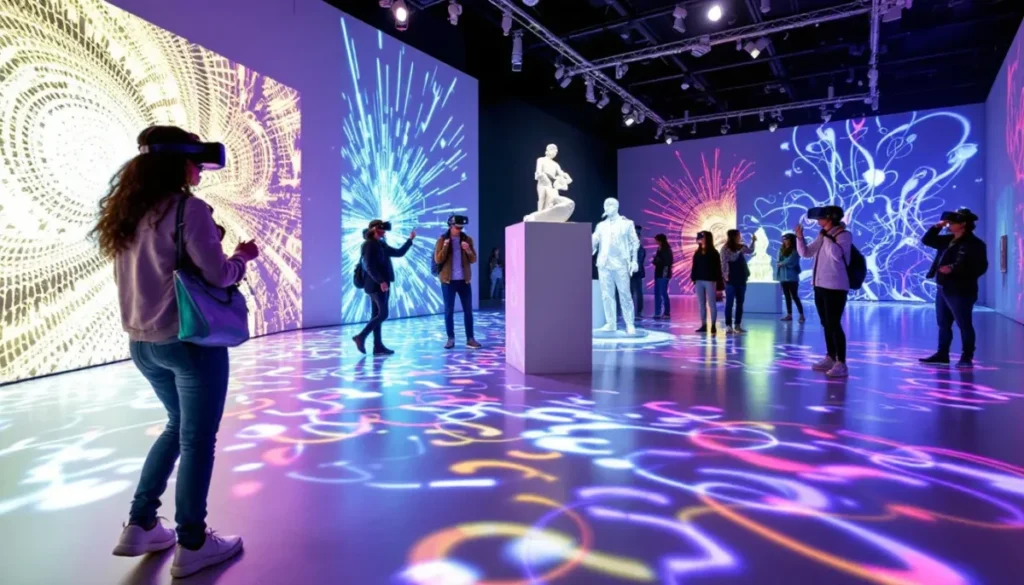
Virtual reality (VR) is revolutionizing both how art is created and experienced. VR tools allow artists to paint and sculpt in three-dimensional space, completely transforming the creative process. Applications like Tilt Brush and Gravity Sketch let artists work at any scale, defying physical limitations.
For art viewers, VR offers unprecedented immersive experiences. Virtual galleries can showcase work to global audiences, while interactive installations place viewers inside the artwork itself. Museums worldwide are exploring VR to make collections more accessible and engaging.
As technology expert Dr. Sarah Thompson explains in this video exploring virtual art galleries, “Virtual reality isn’t just changing how we view art—it’s expanding our very definition of what an art experience can be.”
NFTs and the Digital Art Market Revolution
Non-fungible tokens (NFTs) have dramatically impacted the art market by solving a fundamental problem: how to establish ownership and scarcity for digital artworks that can be infinitely copied.
NFTs create verifiable proof of ownership for digital assets, enabling artists to sell digital originals in ways previously impossible. This technology has created new revenue streams for digital creators and opened collecting to new audiences.
The NFT art market has experienced tremendous volatility, with some works selling for millions while others go unnoticed. Despite the fluctuations, NFTs have permanently changed how digital art is valued and collected.
Technology Democratizing Art Creation and Global Distribution
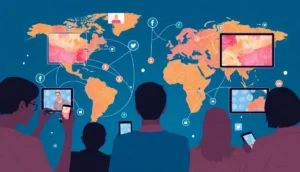
Perhaps the most profound technology influence on art is the democratization of both creation and distribution. Digital tools have made artistic expression more accessible, while online platforms have connected artists directly with audiences worldwide.
Artists can now:
- Learn techniques through online tutorials instead of formal education
- Use affordable digital tools instead of expensive physical materials
- Reach global audiences without gallery representation
- Sell directly to collectors without intermediaries
- Join international communities of like-minded creators
This democratization has diversified artistic voices and created opportunities for artists from underrepresented communities to find recognition that traditional art institutions might have denied them.
According to a recent Art Market Trends 2025 report, online art sales continue to grow, with social media becoming the primary discovery channel for new collectors.
The Future of Technology Influence on Art
As technology continues to evolve, we can expect even more profound changes in artistic creation, distribution, and appreciation. Emerging technologies like brain-computer interfaces, advanced AI, haptic feedback, and the metaverse will likely create entirely new art forms and experiences we can hardly imagine today.
What remains constant is the human creative impulse that drives artistic expression. Technology will continue to provide new tools, but the fundamental desire to create, communicate, and connect through art remains essentially human.
As we look to the future, the technology influence on art will likely continue blurring boundaries—between creator and audience, physical and digital, human and machine. This evolution promises exciting new possibilities while challenging us to reconsider fundamental questions about creativity, authenticity, and artistic value.
FAQ: Technology Influence on Art
How has technology changed the definition of art?
Technology has expanded what we consider art by introducing new mediums, tools, and distribution methods. Digital art, interactive installations, and AI-generated works have all pushed the boundaries of traditional definitions. However, the core elements of artistic expression—creativity, intention, and emotional impact—remain central regardless of the technology used.
When did digital art begin?
Digital art emerged in the late 1950s and early 1960s when scientists and engineers began experimenting with computer graphics. Artists like Vera Molnár and Charles Csuri were pioneers in using algorithms to create visual compositions. The first major exhibition of computer art was held in 1965 at Technische Hochschule in Stuttgart, Germany. The field expanded rapidly with the introduction of personal computers in the 1980s and graphic software like Photoshop in the 1990s.
Can AI create real art?
This remains a philosophical question with no definitive answer. AI can generate images that are visually impressive and emotionally moving—qualities we associate with art. However, AI lacks intention, personal experience, and cultural context that many consider essential to “real” art. Most experts view AI as a powerful tool that requires human direction and curation to create meaningful art, rather than an autonomous creator.
What are the ethics of AI-generated artwork?
Key ethical concerns include: proper attribution (acknowledging both human and AI contributions), copyright questions (who owns art created by AI trained on other artists’ work), potential economic impacts on human artists, authenticity and disclosure to audiences, and the environmental costs of computing resources needed for AI art generation. The field is evolving rapidly, with artists, technologists, and legal experts working to establish ethical frameworks.
How is technology impacting art galleries and museums?
Technology is transforming cultural institutions through virtual tours, augmented reality experiences, interactive displays, and digital archives that make collections more accessible globally. Museums increasingly use data analytics to understand visitor preferences and personalize experiences. Social media has become crucial for audience engagement, while technologies like blockchain verify authenticity and provenance. During the COVID-19 pandemic, digital platforms became essential, accelerating adoption of virtual exhibitions and online programming that continues to complement physical experiences.
The undeniable technology influence on art continues to reshape how we create, share, and experience artistic expression. As tools evolve and barriers fall, more diverse voices contribute to our collective creative conversation—perhaps the most meaningful impact technology can have on the artistic world.

